Physical Address
304 North Cardinal St.
Dorchester Center, MA 02124
Dementia is a cognitive disorder that leads to interference with daily functioning and results in loss of independence ( Table 371-1 ). Dementia can range in severity from mild, when a patient may still be independent in a few activities, to severe, when total dependence occurs. Mild cognitive impairment is the term that describes the earlier phase of symptomatic cognitive impairment that precedes mild dementia ( Table 371-2 ). The definitional boundary between mild cognitive impairment and dementia is based on the preservation or loss of independence in daily life. Given the diversity of life experiences and circumstances, the concept of the distinction between mild cognitive impairment and dementia has more conceptual clarity than operational precision. Indeed, the spectrum of symptomatic cognitive impairment is a continuum.
Dementia is a persistent cognitive impairment that interferes with the ability to function at work or at usual activities; and
|
The cognitive impairment of dementia is detected and diagnosed through a combination of:
|
The cognitive or behavioral impairment of dementia involves at least two of the following domains:
|
| The presence of a new memory complaint, preferably corroborated by an informant |
| Objective evidence of an impairment in episodic memory (for age) |
| Normal general cognitive functioning as measured by a brief cognitive assessment |
| No substantial interference with work, usual social activities, or other activities of daily living |
| No dementia |
The majority of conditions that result in symptomatic cognitive impairment are of gradual onset, are progressive in course, and occur in persons with previously normal cognition. Some diseases that lead to dementia, such as those caused by an acute neurologic illness secondary to stroke ( Chapter 375 ), encephalitis ( Chapter 383 ), or head trauma ( Chapter 368 ), may begin abruptly and then remain static for long periods. Conversely, a small subset of dementias, such as Creutzfeldt-Jakob disease, has a rapid onset and a course that can run for less than a year. Dementia may also occur in persons with developmental disabilities and long-standing cognitive deficits.
The prevalence and incidence of mild cognitive impairment and dementia increase with advancing age. Both are uncommon before 50 years of age. In individuals older than age 65 years, who comprise 95 to 97% of all patients with dementia, the prevalence of dementia of all types is about 7%. In the age range of 65 to 69, the prevalence of dementia is only 1 to 2%, but it increases to 20 to 25% in the 85- to 89-year age range and continues to rise steadily thereafter. The incidence of new cases of dementia is about 1 per 100 per year at the age of 70 and rises to about 2 to 3 new cases per 100 per year by about the age of 80. Incidence rates continue to rise into the ninth and tenth decades of life. The incidence and prevalence of mild cognitive impairment are roughly the same as those of dementia. This means, for example, that the prevalence of symptomatic cognitive impairment after age 65 years is about 14%. With the dramatic increase in longevity, the societal burden of dementia has risen substantially. Interestingly, however, the incidence rate of dementia has declined over the past three decades, likely related to better and earlier treatment of cardiovascular risk factors.
In absolute numbers, far more women than men have dementia because women live longer. However, men and women have an equal age-adjusted risk for the development of dementia. Blacks and Latinx adults are at greater risk of dementia, probably because of disparities in socioeconomic status and medical care. Risk factors include the APOE ɛ4 allele, current depressive symptoms, exposure to anticholinergic drugs, midlife onset of diabetes, hypertension or hyperlipidemia, and vascular diseases such as atrial fibrillation or stroke. Normal blood pressure is associated with a lower risk of dementia, treating hypertension reduces the risk of dementia and targeting a systolic blood pressure below 120 mm Hg versus 140 mm Hg further reduces the combined risk of mild cognitive impairment and dementia. A parental history of dementia before age 80 years increases the risk for dementia by about two- to six-fold independent of all currently known genetic risk factors. A healthy lifestyle may protect against dementia, and intellectual engagement raises cognitive performance and may be associated with a slower decline in cognitive function.
Symptomatic cognitive impairment is the culmination of dysfunction in the cerebral hemispheres, especially the association cortices, hippocampal formations, their supporting subcortical nuclear structures (e.g., caudate nuclei, thalamus), and their white matter interconnections. Specific diseases that cause mild cognitive impairment and dementia do so by affecting particular parts of the cerebral cortex, subcortical nuclei, or the underlying white matter pathways linking different cortical regions. Especially in patients over the age of 75 to 80 years of age, most dementia has a multifactorial basis rather than representing a single biologic process. The failure to remove the waste products of brain metabolism, either through endosomal recycling or through clearance via bulk transport into cerebrospinal fluid pathways, is thought to be a final common pathway to dementia in neurodegenerative diseases. ,
Any of the major domains of cognition—episodic memory, executive cognitive functioning, visuospatial function, or language—may be affected in dementia ( Chapter 370 ). Because Alzheimer disease is the most common cause of mild cognitive impairment and dementia, anterograde amnesia is typically present first and most intensely in the majority of dementia patients. In other dementing illnesses, deficits in the other cognitive domains may be dominant. Although persons with mild cognitive impairment often retain some sense of their loss of cognitive capacities, a pervasive and nearly invariant aspect of dementia is a loss of insight (anosognosia) into the extent of one’s cognitive and functional losses.
Neuropsychiatric symptoms are also common in dementia. Apathy and loss of initiative are almost always present. Depression and anxiety are frequent, as are irritability, paranoia, delusional thinking, and hallucinations. Daily functioning of patients with dementia is compromised. In early dementia, difficulty is likely to be present in management of finances and medications, independent travel, preparation of meals, and keeping of appointments. In more advanced disease, difficulty becomes evident in basic activities of daily living such as bathing, dressing, toileting, and feeding oneself. Dementias secondary to cerebrovascular or Lewy body disease are often associated with specific abnormalities in strength, coordination, gait, or balance. Alzheimer disease typically has no associated motor abnormalities.
Mild cognitive impairment and dementia are strictly clinical diagnoses based on evidence of cognitive dysfunction in both the history and the mental status examination. The key elements of the history flow from their definitions: What is the evidence for impairment in one or more domains of cognition? What is the evidence that daily functioning is affected? The mental status examination is necessary to establish that alertness is preserved (i.e., the patient does not have delirium [ Chapter 361 ]) and to determine what specific areas of cognition exhibit directly observable impairment. For diagnosis of the syndrome of dementia, no laboratory test supersedes the clinical history and mental status examination. Laboratory testing is critical, however, to determine the cause of the cognitive disorder.
Bedside testing of mental status is based on the principles of cognitive neurology ( Chapter 370 ). For moderate or severe dementia to be distinguished from normal cognitive states, a bedside mental status examination such as the Mini-Cog test (see Table 361-5 in Chapter 361 ) is accurate. However, for mild cognitive impairment and mild dementia, bedside mental status examinations lack sensitivity (i.e., they fail to diagnose some cases at the milder end of the spectrum). For patients with suspected mild cognitive impairment or dementia, neuropsychometric testing is a useful adjunct to the bedside examination. The neurologic examination is also important for evaluation of signs of specific diseases, including signs of cerebrovascular disease (e.g., hemiparesis [ Chapter 375 ]) and signs of extrapyramidal disease (e.g., rigidity, bradykinesia, resting tremor [ Chapter 378 ]).
Mild cognitive impairment and dementia must be distinguished from other disorders of cognition ( Fig. 371-1 ). Delirium ( Chapter 361 ) also affects cognition directly; key features distinguishing it from dementia include impaired arousal and attention. Delirium is almost always of sudden onset, whereas the majority of cases of dementia are of gradual onset.
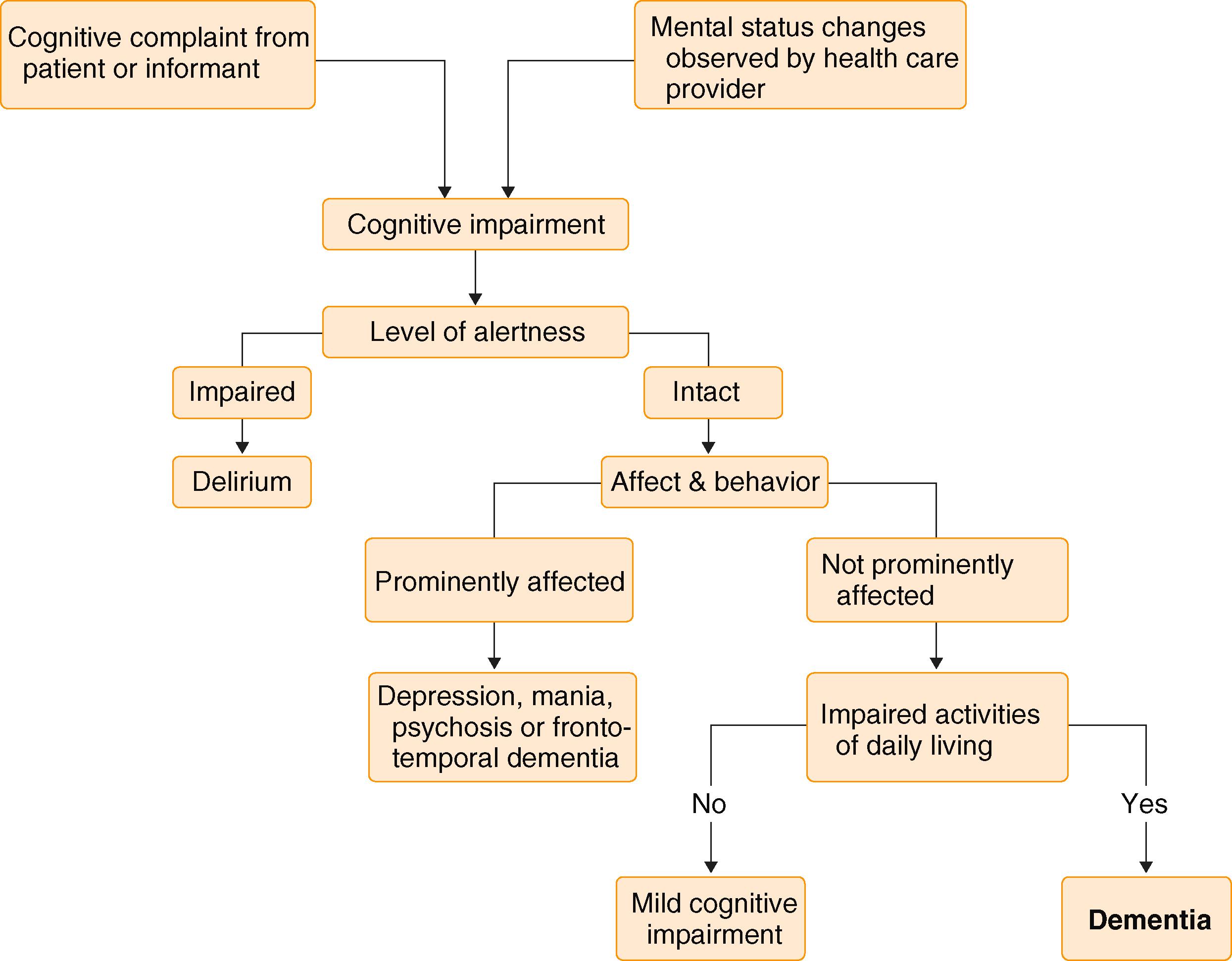
Primary psychiatric diseases ( Chapter 362 ) such as major depression, bipolar disorder, and schizophrenia may also impair cognition. In mild cognitive impairment and dementia, however, the impairment in cognition is typically equivalent to or more pervasive than the changes in mood and behavior.
The principal diseases that cause mild cognitive impairment and dementia are three neurodegenerative diseases—Alzheimer disease, Lewy body disease, and frontotemporal lobar degeneration—and cerebrovascular disease ( Fig. 371-2 ). The neurodegenerative diseases are typically slow and insidious in onset and inexorably progressive. Mild cognitive impairment and dementia secondary to cerebrovascular disease may be of either sudden or gradual onset.
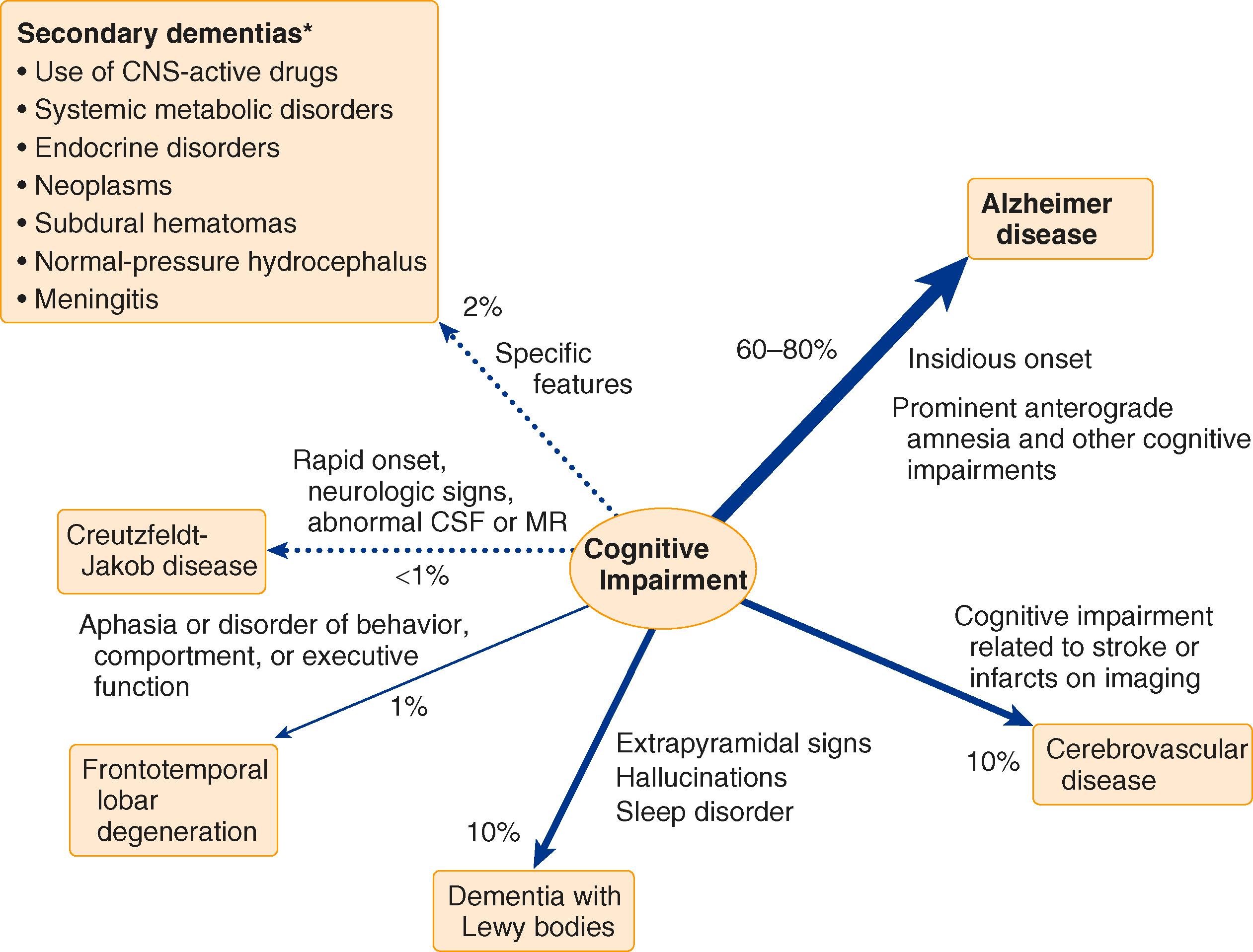
Many much less common secondary causes account for less than 2% of all dementias. Drug intoxication ( Chapters 365 and 384 ), metabolic disorders ( Chapter 189 ), central nervous system infections ( Chapters 381 to 383 ), and brain structural lesions ( Chapter 370 ) are typically subacute in onset; if they are diagnosed and treated early, the cognitive deficits improve or resolve completely. A number of medications such as sedatives, pain medications, corticosteroids, digoxin, and others cause mental confusion, particularly but not always at toxic levels ( Chapter 96 ). Metabolic disorders that may also cause subacute confusion and produce a cognitive disorder include hypothyroidism or hyperthyroidism ( Chapter 207 ), vitamin B 12 deficiency ( Chapter 384 ), chronic liver disease ( Chapter 139 ), chronic renal failure ( Chapter 116 ), and hypocalcemia or hypercalcemia ( Chapter 227 ). Chronic viral infections of the brain, especially human immunodeficiency virus infection, frequently cause dementia ( Chapter 359 ). Chronic meningitides in the differential diagnosis of dementia include cryptococcal meningitis ( Chapter 309 ), tuberculous meningitis ( Chapter 299 ), and tertiary syphilis ( Chapter 295 ). Finally, structural lesions of the brain, including primary and metastatic tumors ( Chapter 175 ), chronic subdural hematomas ( Chapter 368 ), and normal-pressure hydrocephalus, can cause a syndrome resembling dementia that consists of a subacute or slowly progressive decline in cognition with few or no other neurologic symptoms or signs.
Except for the secondary causes of mild cognitive impairment and dementia and the rare dementing illnesses caused by single episodes of brain injury (e.g., severe head trauma, anoxic encephalopathy), dementia is a condition that invariably leads to worsening of cognition and function. Almost all patients who have more than mild cognitive impairment worsen over the course of several years if they do not die from other causes. The rate of cognitive decline is variable among individuals and, of course, also varies with the specific disease. In general, dementia can be said to decrease life expectancy by half compared with the life expectancy of nondemented individuals.
The terminal stage and end-of-life care issues ( Chapter 3 ) associated with the common dementias are usually similar. Dementia itself does not directly cause death, but it is strongly linked to reduced survival. Patients with dementia typically die of the same illnesses that affect debilitated individuals, such as sepsis, pneumonia, pulmonary embolism, or heart disease.
Most patients with dementia experience their terminal illnesses in hospitals or extended care facilities. Given the inexorably progressive nature of most dementing illnesses and their likelihood of producing severe and completely disabling cognitive and functional impairment, it is widely accepted that patients with end-stage dementia should receive conservative care. Feeding tubes and ventilatory support should not generally be considered.
Pharmacologic treatment of persons with mild cognitive impairment or dementia should be focused on the specific disease causing the cognitive disorder. Unfortunately, symptomatic treatments are currently available only for Alzheimer disease dementia. Management of persons with symptomatic cognitive impairment, on the other hand, involves issues that are common to all etiologies. Principles of care include disclosure of the diagnosis, education and support of caregivers, assessment of functional status, screening and management of behavioral and psychiatric symptoms, cognitive stimulation, addressing safety concerns, assessing driving status, advance care planning, pain assessment, and pharmacologic treatment of dementia.
Alzheimer disease, which is a pathophysiologic process involving β-amyloidosis and limbic and isocortical neurodegeneration with tauopathy, produces a cognitive disorder that usually progresses to severe dementia in which anterograde amnesia is the initial dominant symptom ( Table 371-3 ). The clinical diagnosis implies that the causative pathologic process is of the Alzheimer type, whereas the pathologic diagnosis rests on the findings of characteristic histopathologic features.
| The clinical diagnosis of probable Alzheimer disease dementia is made when: |
Criteria for dementia met (see Table 371-1 ), and the illness has the following characteristics:
|
| The diagnosis of probable Alzheimer disease dementia should not be applied when there is substantial evidence for another neurodegenerative disease, extensive cerebrovascular disease, or a non-neurologic medical comorbidity or medication use that could have a substantial impact on cognition |
| Research criteria for probable Alzheimer disease dementia with higher certainty when imaging or cerebrospinal fluid biomarkers are available: |
| Alzheimer disease is considered the cause of cognitive impairment when β-amyloid markers (in cerebrospinal fluid or by PET imaging) are abnormal and tau markers (e.g., Aβ42/t-tau, Aβ42/p-tau, or the microtubule-binding region of tau containing the residue 243) are abnormal |
| Alzheimer disease pathophysiology is considered present but of uncertain etiologic significance when β-amyloid markers (in cerebrospinal fluid or by PET imaging) are abnormal but tau markers are normal |
Between 60 and 80% of all dementing illness is due to Alzheimer disease. Among all individuals older than 65 years, the prevalence of Alzheimer disease is estimated to be about 5%. As with dementia in general, the prevalence doubles in every 5-year interval after age 65, and the incidence continues to rise into the 10th and 11th decades of life. Men and women may be equally affected, although on an absolute basis, far more women have prevalent Alzheimer disease because women live longer than men. There are no ethnic or racial differences in the predilection for Alzheimer disease.
Established risk factors for Alzheimer disease include advancing age and a family history. Most patients with Alzheimer disease have other comorbid brain pathologies, which may effectively lower the threshold for dementia in persons who also have Alzheimer pathology. For example, midlife vascular risk factors and elevated low-density lipoprotein (LDL) levels specifically may be associated with elevated brain β-amyloid later in life. Low educational achievement is a consistent risk factor, likely in part because it is associated with less cognitive reserve, but educational level also may be a proxy for other factors, such as socioeconomic status or the early childhood medical and psychosocial environment, that raise the risk of concomitant cerebrovascular disease. Head injury may be a risk factor for Alzheimer disease, but head injury acts mainly through chronic traumatic encephalopathy ( Chapter 368 ).
The histopathologic diagnosis of Alzheimer disease is based on the joint presence of a substantial cerebral burden of neuritic plaques and neurofibrillary tangles. Neuritic plaques consist of a core of aggregated β-amyloid peptide surrounded by degenerating neurites, which are fragments of axons and dendrites. β-Amyloid contains 39 to 42 amino acids and is proteolytically derived from a larger protein, the amyloid precursor protein. Neurofibrillary tangles are intracellular aggregations of an excessively phosphorylated form of the microtubule-associated protein tau. The altered tau protein self-aggregates and forms neurofibrillary tangles. In a low-powered microscopic section of frontal, temporal, or parietal cortex, at least six neuritic plaques and neurofibrillary tangles should be visible for the diagnosis of Alzheimer disease to be made.
The progression of changes of β-amyloidosis follows a roughly predictable pattern in Alzheimer disease. Positron emission tomography (PET) imaging with ligands that bind to β-amyloid shows that β-amyloid begins to accumulate in the neocortex as long as 20 years before dementia occurs. Soluble aggregates of β-amyloid in oligomeric (consisting of a small number of monomers) forms may be the key pathogenic molecules that eventually induce or accelerate neuronal injury. By the time clinical dementia due to Alzheimer disease is present, large numbers of β-amyloid peptide–containing deposits invariably are found in neuritic plaques in the neocortex. Neuritic plaques represent the end stage of the Alzheimer process. Because β-amyloidosis begins well before clinical symptoms appear and probably reaches a plateau in terms of abundance, the amount of β-amyloidosis does not closely mirror the severity of dementia in Alzheimer disease.
The regional extent of neurofibrillary tangles in Alzheimer disease anticipates and parallels the clinical progression of the disease from an amnestic disorder to a multidomain cognitive disorder. Neurofibrillary tangles appear in the medial temporal lobe and brain stem in cognitively normal persons by the fourth decade of life. In persons destined to develop Alzheimer disease, a critical part of the pathophysiology involves transsynaptic spread of neurofibrillary tangle pathology to cortical association areas. At the time clinical symptoms develop, neurofibrillary tangles are found in association neocortices of the frontal, parietal, and temporal lobes. It is only in the most severe and final stages that neurofibrillary tangles are found in the occipital lobes and primary motor and sensory cortices. The location of neurofibrillary tangles corresponds faithfully to the clinical evolution of specific symptoms and severity of Alzheimer disease. In mild cognitive impairment, the earliest clinical manifestation of Alzheimer disease, the most intense burden of neurofibrillary tangles is in the entorhinal cortex and hippocampi, precisely the regions involved in declarative episodic memory. Hippocampal atrophy is characteristic, and reductions in hippocampal volumes may be observed on magnetic resonance imaging (MRI; Fig. 371-3 ). Involvement of the association neocortices with neurofibrillary tangles represents the histopathologic correlate of the progression to dementia. Quantitative MRI in patients with mild cognitive impairment who later progress to dementia shows increasing atrophy of key cortical association areas, such as the lateral temporal lobes, inferior parietal lobes, posterior cingulate cortex, and lateral frontal lobes. Reflecting the spread to association neocortex, language functions, visuospatial functions, and executive cognitive functions typically become impaired some time after declarative episodic memory dysfunction occurs.
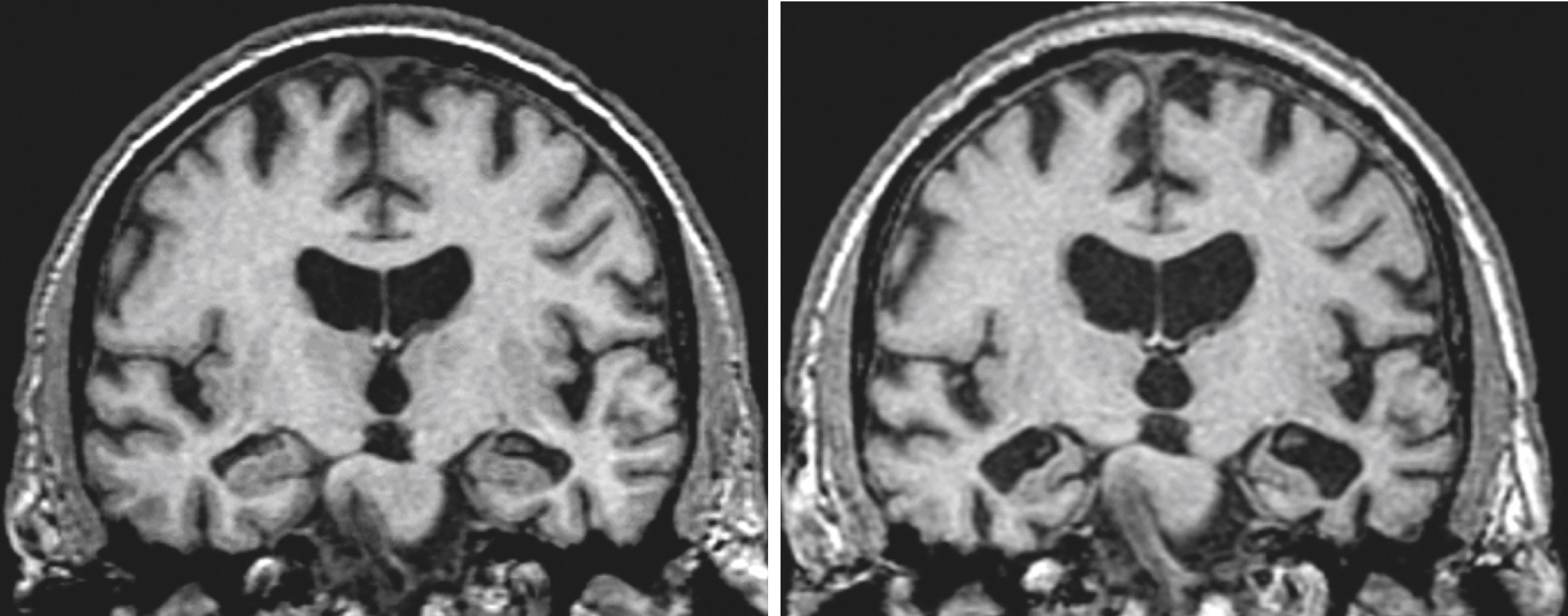
The most consistent neurotransmitter deficit in Alzheimer disease is in cholinergic neurotransmission. The cells of origin of hippocampal and neocortical cholinergic projections are located in the septum, diagonal band, and nucleus basalis. Neurofibrillary tangles accumulate in the neurons in these regions as Alzheimer disease develops, but there is also neurochemical evidence that these neurons are stressed much earlier in the disease.
The overwhelming majority of Alzheimer disease is due to sporadic (not genetic) disease. However, in a very small number of instances, Alzheimer disease occurs as an autosomal dominant disease. The three known genes involved in autosomal dominant Alzheimer disease all are directly involved in the production of β-amyloid peptide. The first is the amyloid precursor protein (APP) gene, located on chromosome 21q21.3. Over 60 known mutations in this gene lead to excess production of β-amyloid and are reliably associated with a very early onset (20 to 50 years of age) of Alzheimer disease. Another line of evidence implicating the APP gene in Alzheimer disease is the invariable appearance of the pathologic process of Alzheimer disease in individuals with Down syndrome (trisomy 21 [ Chapter 32 ]) who have an extra copy of the APP gene as a result of the trisomy.
The other two genes associated with autosomal dominant Alzheimer disease are the presenilin 1 and 2 genes, located on chromosomes 14q24.3 and 1q31.42. Over 300 presenilin 1 mutations account for the majority of autosomal dominant Alzheimer disease; mutations in presenilin 2 are least common. Both genes code for a similar protein known as presenilin. Presenilin is involved in the proteolysis of the APP molecule at the gamma cleavage site. Presenilin mutations alter the balance of APP cleavage products, including β-amyloid and other peptides that may influence synaptic functioning. The presenilin mutations are almost always associated with early-onset (age 40 to 60 years) Alzheimer disease, but a rare PSEN1-E280A mutation appears to be remarkably protective.
Studies of the familial aggregation of Alzheimer disease have shown that later-onset disease also displays genetic risks, but only a few genes have been definitively linked to later-onset Alzheimer disease. The most prominent gene related to later-onset Alzheimer disease, located on chromosome 19q13.2, encodes apolipoprotein E (apo E), a protein involved in lipid transport. In humans, three allelic variants of apolipoprotein gene (APOE) are determined by differences in the amino acids cysteine and arginine at positions 112 and 158 of the 299–amino acid protein. One of the allelic variants, with arginine at both positions, designated the ɛ4 variant, is strongly associated with a 14-fold increased risk for Alzheimer disease in homozygotes and a 3-fold increase in heterozygotes. In many series, almost 50% of Alzheimer disease dementia patients, but only about 25% of nondemented controls, have at least one copy of the APOE ɛ4 allele. The presence of an APOE ɛ4 allele does not always cause Alzheimer disease in that the disease never develops in some carriers of the genotype. The mechanism by which the APOE ɛ4 allele predisposes to Alzheimer disease is not established, but the tertiary structure of the APOE protein with arginine at positions 112 and 158 may lead to impaired binding to β-amyloid, which in turn reduces the clearance of β-amyloid from cells.
A very rare missense mutation in the TREM2 gene also increases the risk for Alzheimer disease. The R47H variant of TREM2 increases the risk for Alzheimer disease three-fold. The pathophysiology appears to be impaired containment of inflammatory processes rather than a direct effect on neurologic function. Rare loss-of-function mutations in ABCA7 uniformly lead to classical Alzheimer disease, but with a widely variable age of onset.
The early course of symptomatic cognitive impairment due to Alzheimer disease is dominated by difficulties with anterograde amnesia. Some of the usual complaints include forgetting recent events and conversations, misplacing items, problems with keeping track of the date, getting lost in familiar surroundings, and problems with remembering to complete tasks. The frequency and severity of the memory lapses progress from occasional difficulty to more pervasive and consistent failure.
In mild cognitive impairment and mild dementia due to Alzheimer disease, episodic memory function may be lost. Familiarity and access to previous knowledge may allow patients to function in their usual daily routines as long as nothing out of the ordinary is required of them. They may still retain the ability to prepare simple meals and take walks in their neighborhood without getting lost. However, even in mild Alzheimer disease, medication-taking errors and difficulty managing money or balancing a checkbook are likely to occur. Traveling to unfamiliar places often accentuates confusion. Changes in personality commonly accompany the cognitive losses. Apathy, loss of initiative, and loss of interest in previous hobbies and pastimes are ubiquitous in early symptomatic Alzheimer disease.
As the disease progresses, the ability to perform necessary daily tasks becomes more and more difficult to the point that the patient will need assistance preparing meals, paying bills, taking transportation, and keeping house. As the disease moves into the severe stages, assistance and supervision in basic activities such as bathing, dressing, toileting, and eating become necessary.
In the terminal stages of the disease, all communicative abilities may be lost. Mobility may still be preserved until late in the disease. Alzheimer disease dementia patients commonly die of illnesses that strike other debilitated elderly individuals, such as sepsis, pneumonia, and heart failure.
The duration of the course of dementia due to Alzheimer disease is long but variable. The time from mild dementia to death may be as short as 2 to 3 years or may be well over a decade. For patients in whom mild dementia is diagnosed, about 10% per year reach the stage of severe dementia.
Rarely, Alzheimer disease is associated with prominent symptoms in cognitive domains other than memory. The most common of the atypical syndromes is one in which profound visuospatial deficits occur without the typical severe anterograde amnesia. This syndrome is referred to as posterior cortical atrophy. Patients with posterior cortical atrophy have a slower course compared with the typical amnestic dementia of Alzheimer disease, and, until the severe stages, have a relative preservation of short-term memory function. Some patients with other variants may have more dysfunction in language and executive tasks than in memory per se.
The diagnosis of mild cognitive impairment or dementia due to Alzheimer disease is largely a clinical one based on the history and examination. The key elements in the history are a gradual onset and insidious progression of cognitive impairment, especially anterograde amnesia. The mental status examination should demonstrate impairment in short-term memory and other cognitive deficits. The clinical diagnosis of Alzheimer disease should be thought of as a diagnosis of inclusion: if the history and examination are compatible with Alzheimer disease and if certain exclusions can be verified, the diagnosis can be made with moderate confidence. Recent PET imaging studies have shown that non-Alzheimer disease etiologies can sometimes mimic the amnestic syndrome of Alzheimer disease.
Cerebrospinal fluid (CSF) protein markers (β-amyloid and tau) (see Table 371-3 ) and brain imaging (structural MRI, 18 fluorodeoxyglucose PET [ Fig. 371-4 ], amyloid positron emission tomography [ Fig. 371-5 ], and tau positron emission tomography [ Fig. 371-6 ] ) are being used in research settings to enhance the precision of a diagnosis of Alzheimer disease as a cause of symptomatic cognitive impairment. For example, amyloid PET scanning and measurement of biomarkers can identify early-stage Alzheimer disease with sensitivities of about 97% and specificities of about 83%. Such tests also show promise for discriminating Alzheimer disease from other neurodegenerative diseases and for identifying patients who might benefit from newer therapies. For experimental therapeutics, efforts are now underway to use CSF or biomarkers to diagnose Alzheimer disease before individuals develop symptoms.
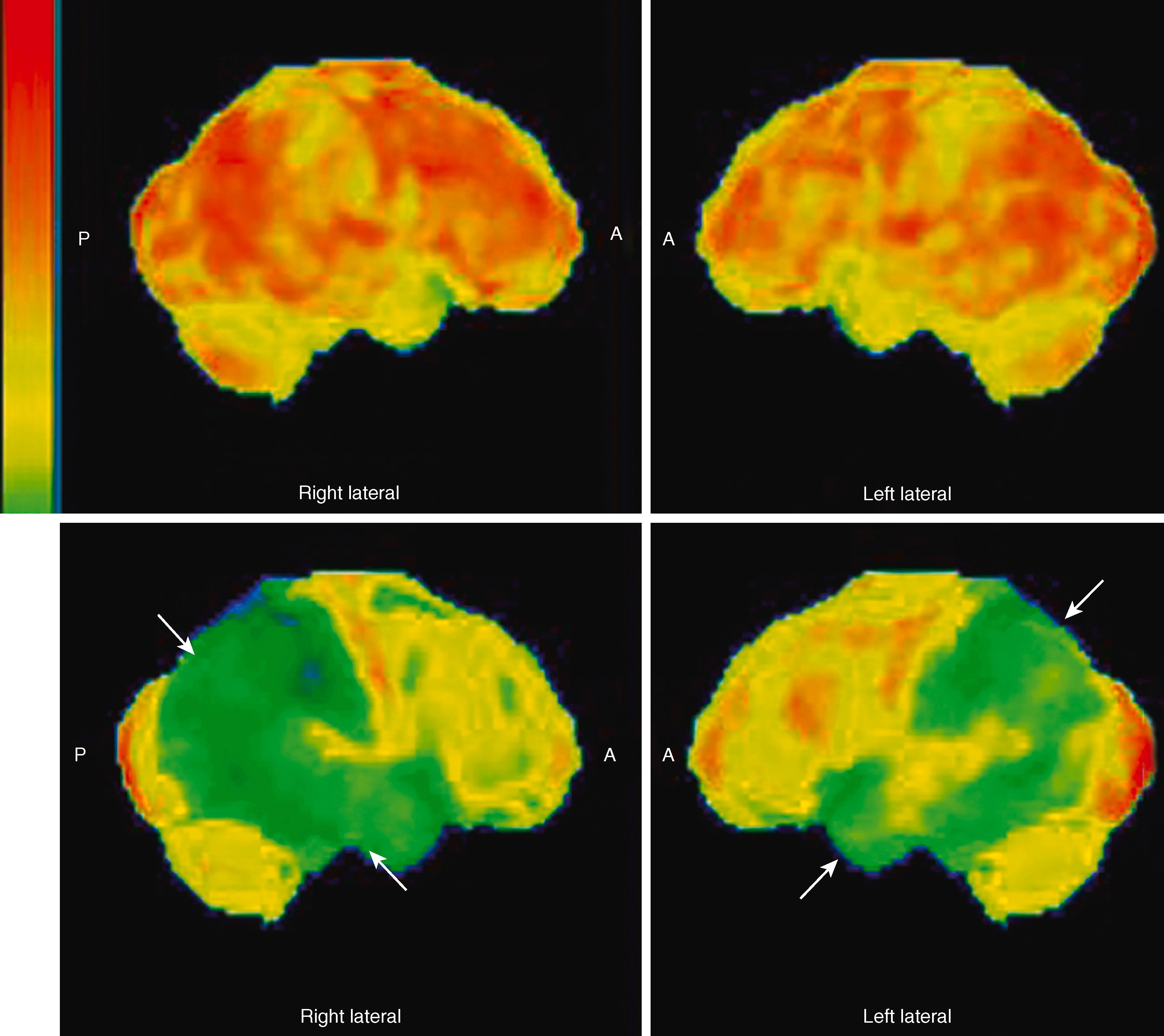
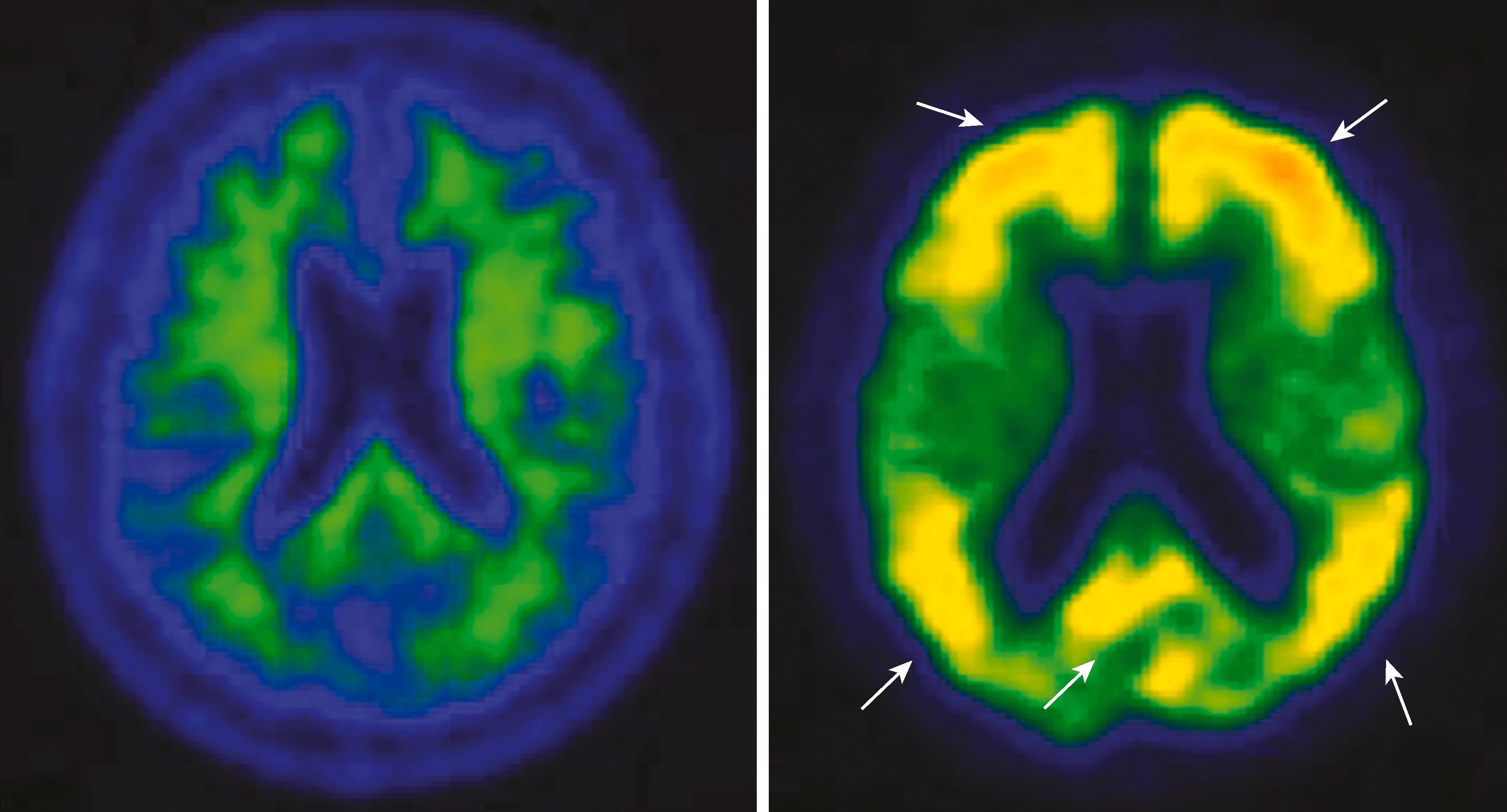
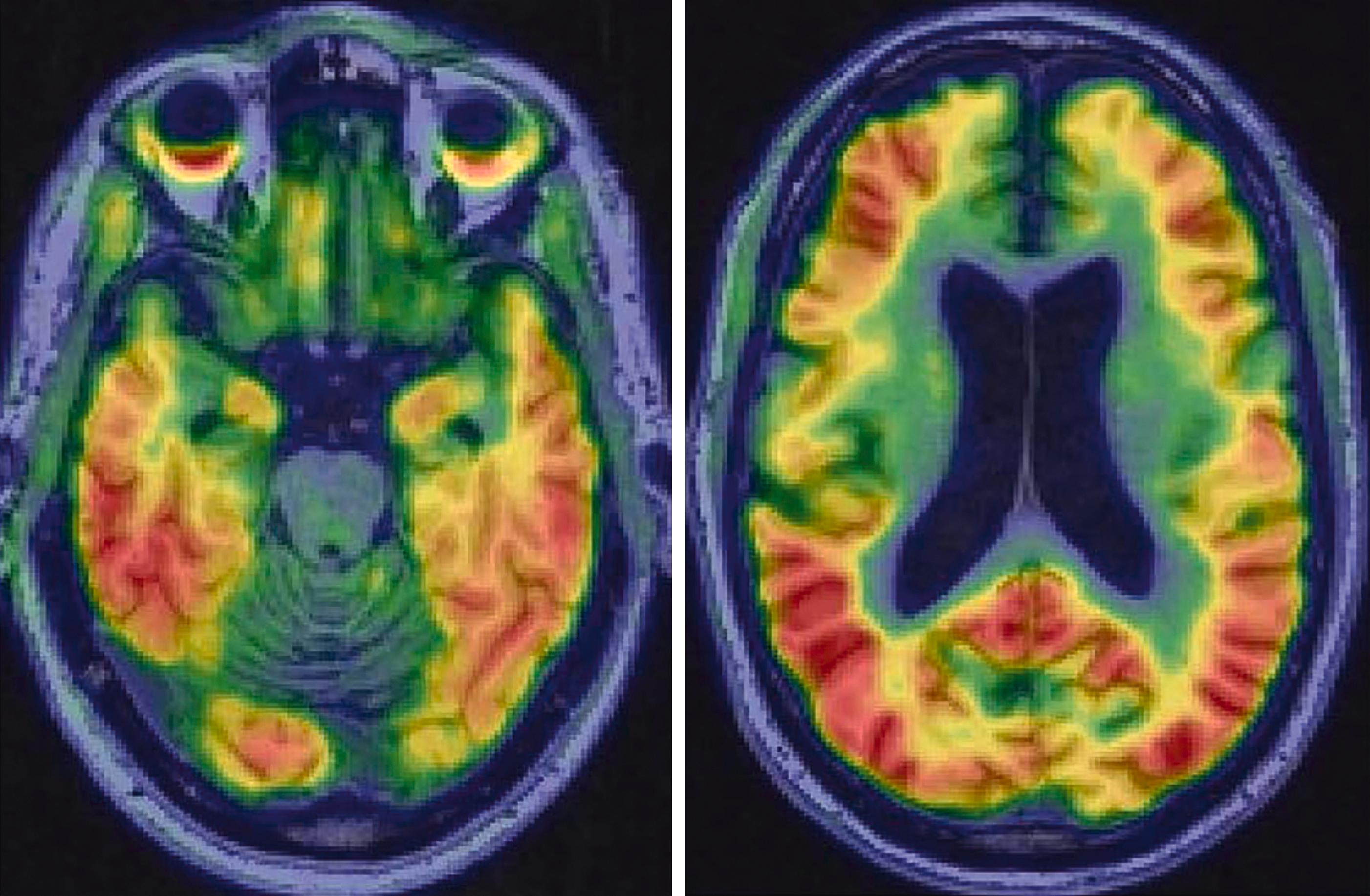
Become a Clinical Tree membership for Full access and enjoy Unlimited articles
If you are a member. Log in here